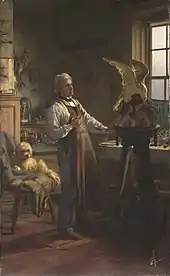John Hancock (ornithologist)
John Hancock (24 February 1808 – 11 October 1890) was a British naturalist, ornithologist, taxidermist and landscape architect. Working during the golden age of taxidermy when mounted animals became a popular part of Victorian era interior design,[1] Hancock is considered the father of modern taxidermy [2][3]
.jpg.webp)
Hancock introduced the style of dramatic preparation in taxidermy. One of his famous works "Struggle with the quarry" depicted a falcon attacking a heron which held an eel. This taxidermy mount was an attraction at the 1851 Great Exhibition at the Crystal Palace in London.

Hancock was born in Newcastle upon Tyne and educated at The Royal Grammar School. He was a brother of the naturalist Albany Hancock. The brothers lived with their sister, Mary Jane, at 4 St. Mary's Terrace, Newcastle, now part of a listed terrace at 14–20 Great North Road.[4] His father was also a John Hancock and he ran a saddle and hardware business.
Training and Skills
He may have trained in taxidermy under Richard Wingate, a neighbour of Thomas Bewick.[5] Hancock was a mentor and tutor to the celebrated ornithologist and bird painter, Allan Brooks.[6][7] Hancock was also an artist and produced several lithographic prints in the 1850s depicting his taxidermy preparations. He was also interested in falconry and was especially a fan of the gyrfalcon. Hancock travelled with fellow naturalist William C. Hewitson to Switzerland in 1845.[8]
Publishing
In 1874, Hancock published his Catalogue of the Birds of Northumberland and Durham.
Hancock edited Thomas Bewick's 1847 edition of Birds. In 1868 he planned a layout for Newcastle Town Moor, which was only partly realised. In 1875, he was asked to prepare a plan for Saltwell Park, but declined due to pressure of work.
Museum
The Hancock Museum in Newcastle upon Tyne is named after the Hancock brothers, both of whom took an instrumental part in getting the museum built. Hancock also prepared flat skins for the collection and received specimens from as far as India through correspondents like Edward Blyth. The museum contains many specimens from their collections.[9] Hancock's collection includes a specimen of the red-necked nightjar Caprimulgus ruficollis claimed to be the first one from Britain and continues to stand as a unique record. Suspicions of an error in the records or even of wilful fraud have been dismissed as Hancock was careful in recording collection information. In some specimens such as an alpine swift without location information, he even noted the fact that it was missing accurate location information.[10] Hancock was also the first to record the breeding of the black redstart in 1845.[11]
References
- Davie, Oliver (1900). Methods in the art of taxidermy. Philadelphia: David McKay.
- Brooks, Marjorie (1938). "Allan Brooks: A Biography" (PDF). The Condor. 40 (1): 12–17. doi:10.2307/1363833. JSTOR 1363833.
- Leon Pray (31 July 2015). Taxidermy. Read Books Limited. pp. 8–. ISBN 978-1-4733-7688-5.
- Alder, J; Hancock, A (1907). "Life of Albany Hancock". The British Tunicata. An unfinished monograph. Volume 2. London: Ray Society. pp. xvii–xxviii.
- Gardner-Medwin, David (2002). "Thomas Bewick and John Hancock" (PDF). Cherryburn Times. 4 (2): 1. Archived from the original (PDF) on 16 April 2014.
- Newton, A (1908). "Biographical Notices of the Original Members of the British Ornithologists' Union, of the principal Contributors to the First Series of 'The Ibis,' and of the Officials". Ibis. 2: 177–181. doi:10.1111/j.1474-919X.1909.tb05250.x.
- Shufeldt, RW (1892). Scientific taxidermy for museums. Report of US National Museum. US National Museum. p. 369.
- Lowther, David; Jessop, Leslie. "John Hancock and the "Laemmergeyer of the Alps"" (PDF). Transactions of the Natural History Society of Northumbria. 79: 67–80.
- Howse, Richard (1899). Index-catalogue of the birds in the Hancock collection. Natural History Society.
- Melling, Tim (2009). "Should red-necked nightjar be on the British list" (PDF). British Birds. 102 (3): 110–115.
- Temperley, G.W. (1946). "Breeding of the black redstart in Britain. A century old record" (PDF). British Birds. 39 (4): 110–111.
- IPNI. J.Hancock.